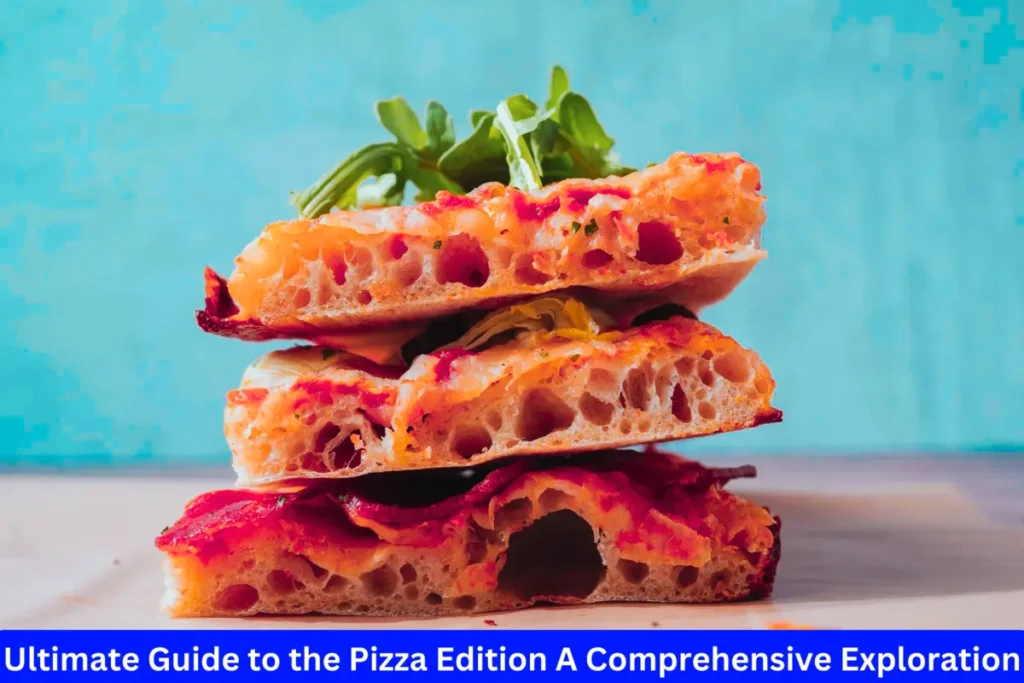The Pizza Edition, the beloved worldwide dish, has a rich history and a wider variety of styles and flavors. This comprehensive guide will explore everything from the origins of pizza to the secrets behind crafting the perfect slice, providing you with the ultimate resource for all things pizza. Whether you are a the Pizza Edition fan or just a casual enthusiast, prepare to dive deep into the world of this timeless culinary masterpiece.
The History of the Pizza Edition
Pizza’s origins can be traced back to ancient times when various cultures enjoyed flatbreads with toppings. However, the Pizza Edition we know today originated in Naples, Italy, during the 18th century. Initially, it was a dish for low-income people, consumed for any meal and sold by street vendors. The turning point came when the tomato was introduced to Europe in the 16th century, eventually becoming a staple ingredient in pizza by the late 18th century.
Legend has it that the modern pizza gained fame when a Neapolitan baker named Raffaele Esposito created the “Pizza Margherita” in 1889. the Pizza Edition was named after Queen Margherita of Savoy to represent the colors of the Italian flag: red (tomato), white (mozzarella), and green (basil).
Regional Variations
Neapolitan Pizza This is the original form of pizza and is characterized by a thin, soft crust with a bubbly, slightly charred edge. The toppings are simple: fresh tomatoes, mozzarella cheese, basil, and extra virgin olive oil.
New York Style Pizza
A derivative of Neapolitan the Pizza Edition, the New York style features a large, thin, and flexible crust that can be folded while eating. It’s typically topped with a slightly sweet, tangy tomato sauce and mozzarella cheese.
Chicago Deep Dish Pizza
In stark contrast to its thin-crust cousins, Chicago deep-dish pizza is known for its high, flaky crust, which can be as deep as an inch. It is baked in a round steel pan that resembles a cake or pie dish. The order of ingredients is reversed, with slices of mozzarella lining the dough, followed by meats and vegetables, and then topped with a can of crushed tomatoes.
Sicilian Pizza
Sicilian pizza, or “sfincione,” features a thick crust and is typically rectangular. It is often topped with a rich tomato sauce, onions, anchovies, herbs, and breadcrumbs, giving it a distinctive taste and texture.
Detroit Style Pizza
This type of the Pizza Edition is rectangular and has a thick, crispy, and chewy crust. It’s unique for its reverse topping style: pepperoni is placed directly on the crust, followed by cheese and other toppings, and finished with tomato sauce spread on top.
Ingredients and Toppings
The choice of ingredients can make or break a pizza. High-quality, fresh ingredients are the heart of a great pizza.
Base Ingredients
- The dough is the foundation of any pizza. It can be made from various types of flour, but most commonly, high-gluten bread flour is used because it can stretch and hold shape.
- Sauce: Tomato sauce is traditional, but white sauces like alfredo or garlic-infused olive oil are also famous.
- Cheese: Mozzarella is the most common, but others like provolone, cheddar, and goat cheese are also widely used.
Toppings
The variety of toppings is nearly endless. Some classic toppings include pepperoni, sausage, and mushrooms. More gourmet options feature arugula, prosciutto, caramelized onions, or artichoke hearts.
Making the Perfect Pizza
Dough Preparation
Slow fermentation is the key to perfect pizza dough, ideally over 24 hours. This process allows the dough to develop flavors and improves the crust’s texture.
Stretching the Dough
Avoid rolling the dough with a rolling pin, as it can deflate the gas bubbles formed during fermentation. Instead, gently stretch it by hand or use gravity to help extend the dough.
Topping Balance
Do not overload the the Pizza Edition with toppings, as this can result in a soggy crust. Balance the quantity and distribution of ingredients evenly.
Baking
Baking pizza in a scorching oven is crucial. Ideally, the oven temperature should be between 450-500°F (232-260°C). If you have a pizza stone or steel, use it to achieve a crispier crust.
Pairing and Serving
Pizza pairs wonderfully with a variety of beverages. A classic choice is soda or beer, but wine lovers can find solace in a good glass of red, particularly a Sangiovese or Syrah. When serving, it’s traditional to cut pizza into wedges or squares, depending on the style.
Conclusion
The Pizza Edition’s universal appeal lies in its simplicity and the infinite variety of ways it can be personalized to suit any taste. Whether crafting it at home or enjoying it at your favorite pizzeria, pizza offers a fulfilling experience that transcends cultures and generations. Dive into creating your own, explore regional styles, and, most importantly, enjoy the delicious journey of pizza exploration.


